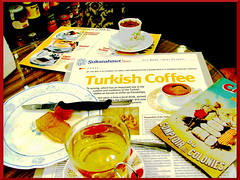
Turkish coffee is one of the simplest ways to make delicious coffee. This is a guide to help you avoid the most common mistakes when making Turkish coffee.
Using the wrong proportion
One of the most common mistakes is using the wrong proportion of coffee to water. If you use too much water or too much coffee the result will not be drinkable! The most common rule is one demitasse cup of water with one teaspoon of coffee. If you want your coffee strong you can use two teaspoons but don't use more...
Using the wrong grind
In order to make Turkish coffee you must use very fine ground coffee. If you use coarser coffee then you will not be able to extract the delicate coffee flavours. You will also fail to create the special coffee foam on top which is highly prized in many Middle East and Balkan countries. This special foam resembles the espresso crema and it is known as kaimaki in Greece. So, make sure that you use very fine ground coffee.
If you want to grind your own coffee, use a high quality burr grinder (manual or electrical). You can also use a mortar and pestle.
Boiling coffee
You must use a Turkish coffee pot to prepare the coffee. Stir the coffee with the sugar a bit to help them mix with the water.
After you light up the fire and you start heating the coffee in the pot, it is very important to watch carefully as the coffee comes slowly to a boil. It's imperative that you don't let it boil!
If it boils then the coffee will get bitter and flat tasting. In order to make delicious Turkish coffee, you must stop the heating when the coffee mixture comes ALMOST to a boil.
At this special moment, the coffee foam forms a ring on top. This foam ring slowly increases in size, closes the gap on top and then the coffee starts rising. As soon as the foam ring closes the gap on top and starts rising out must stop the heating. If you fail to do this it will boil and the flavour will get destroyed. So, just be careful and take it slow!
Bringing to boil more than 3 times
There are some people who prefer to bring the coffee to almost boil more than once. I find this a loss of time and sometimes it can also lead to a loss of quality. Bringing the coffee to almost boil more than 3 times is an exaggeration!
Adding sugar after the boiling
If you want your coffee medium sweet add one teaspoon of sugar for every teaspoon of coffee. If you want your coffee sweet double the amount of sugar. It is important to put the sugar before the heating, to optimize the flavour. The sugar melts and becomes one with the coffee in your mouth.
Using the wrong size pot
In order to make 2 demitasse cups of coffee use a coffee pot (ibrik or cezve) that holds 3 demitasse cups of coffee. You can also measure the capacity of the pot using water. The extra cup is counted to facilitate the whole stirring and foaming process.
Now, you may ask:
"Why can't I use a 5 cup size coffee pot to make 2 cups of coffee? The bigger the better!"
Unfortunately it's not like that!
You see... if you use a much bigger coffee pot this makes the coffee foam creation rather hard. The shape of the coffee pot (conical) facilitates the creation of a special oven like effect that makes the foaming much easier and more precise.
If you use a very big coffee pot then it will be hard to make a nice foam on top of the Turkish coffee. Just try it and you will see the difference!
Using hot water to make it faster
There are many professionals who start with hot water in order to make Turkish coffee faster. Actually they have big boilers and when a customer asks for a cup of Turkish coffee, they pour hot water from the boiler inside their coffee pot, they put coffee and sugar and they boil the whole thing as fast as possible!
The result as you may guess is the destruction of all the delicate coffee flavour. This is because of basic physics and chemistry... hot water (90 C degrees or higher) interacts with the coffee and then as if this is not enough you boil the coffee some more!!!
So just use cold coffee and don't rush. Your taste buds will thank you!
Pouring fast and sloppily
When the heating is done pour the coffee slowly in order to retain the foam on top. If you do it quickly the foam may break apart.
Not letting the coffee settle a bit after serving
After you serve the coffee, the small coffee grounds float everywhere in the cup. Just let them settle for a couple of minutes (except if you like eating coffee :-) )
Not taking enough time to enjoy!
This is in my opinion the greatest mistake of all. We live in very quickly paced timed, full of stress.
Why should you also be in a hurry when drinking your Turkish coffee? Relax! Take a small sip, lay back and enjoy! Share what you learned with your friends and offer them a cup of coffee too, won't you?
Enjoy!
Karolos Tsiligirian is the author of the "Fresh Coffee Encyclopedia" and the owner of FreshCoffeeShop.com
Article Source: http://EzineArticles.com/?expert=Karolos_Tsiligirian
http://EzineArticles.com/?Top-10-Mistakes-Making-Turkish-Coffee&id=1411468
Related links:
Cairo Turkish Style Coffee 1lb Bag
Africa Turkish Style Coffee 1lb Bag










